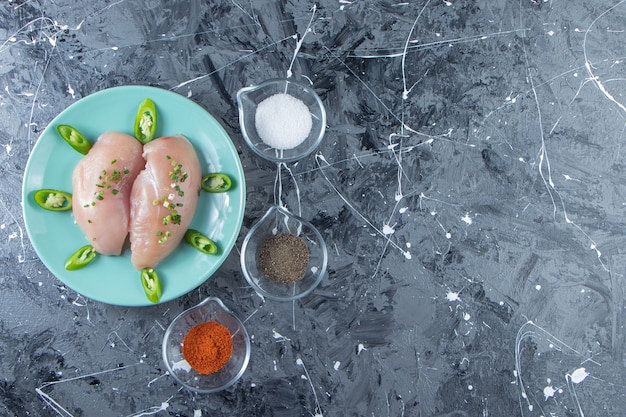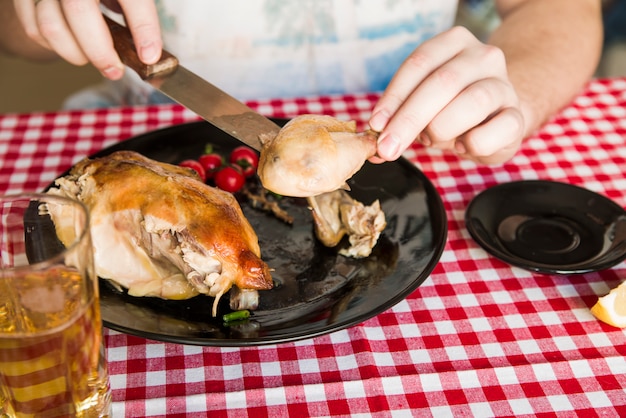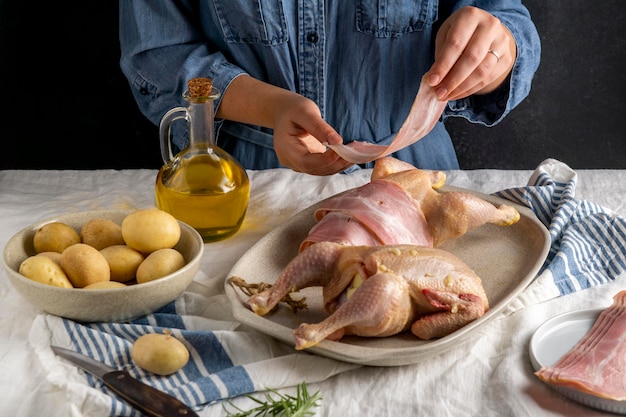Let's be honest, there's nothing quite as satisfying as a perfectly cooked chicken thigh. Those succulent, flavorful bites, with the skin gloriously crispy, are pure culinary bliss. But sometimes, those thighs can end up dry and tough, a tragedy in the making! That's why I'm going to share my tried-and-true secrets to getting those thighs juicy, tender, and bursting with flavor. I'm talking about a symphony of taste, not a dry, rubbery disappointment.
Forget the intimidation factor, my friend! This isn't about complicated techniques or fancy ingredients. It's about mastering the basics, understanding the nuances of chicken, and a little bit of love in the kitchen. I'll break it down step-by-step, so even if you're a complete beginner, you'll be a chicken thigh master in no time. Trust me, you'll be amazed at how easy it is to achieve perfection.
Part 1: Selecting the perfect chicken Thighs

The Secret to juicy chicken: Skin on!
Let's talk about the skin. Now, I know some folks are scared of fat, but when it comes to chicken thighs, embrace it! skin-on chicken thighs are a game-changer, they're like little flavor bombs, locking in moisture and adding that irresistible crispy texture. It's a win-win, my friend. Don't be afraid to get a bit of fat on those thighs, it's going to render down beautifully and create the richest, most delicious sauce. Remember, a little bit of fat is your friend, especially when it comes to juicy, flavorful chicken.
Size Matters!
Now, size matters. For the best results, I prefer thighs that are about the size of my palm. They're big enough to be substantial, but not so huge that they take forever to cook. You want a chicken thigh that's going to cook evenly and not end up with some parts dry and others still raw. Look for thighs that are evenly shaped, with nice, plump muscles. You'll be able to tell the quality by looking at the thighs.
Fresh is Best
Last but not least, fresh is best. Look for thighs with a bright, pink color, not pale or discolored. They should smell clean and fresh, not sour or fishy. If you're buying chicken at the supermarket, grab them from the back of the display. That's where the freshest stuff tends to be. And don't be afraid to ask a butcher for recommendations.
Part 2: Getting Ready to Cook

The Magic of Patting Dry
Once you've got your perfect thighs, it's time to prep them. First, give them a good pat dry with some kitchen paper. This is absolutely crucial, it's like a little pre-tan for your chicken! Wet chicken is going to steam instead of browning, so we want to get rid of all that excess moisture. This will help those thighs achieve a beautiful golden brown crust.
Brining: A Boost of Flavor
Now, here's a little secret that's going to make your chicken taste even more amazing: brining! I love to brine my chicken thighs before cooking, it's like giving them a spa treatment. Brining is simply soaking the chicken in a salt solution, which helps it retain moisture and develop a deeper flavor. I usually use a simple solution of salt and water, but you can add a touch of sugar or lemon juice for extra zing. Let the chicken soak in the brine for at least an hour, but ideally overnight for the best results. If you’re pressed for time, skip it and just dry them well. But trust me, brining is a game-changer.
Seasoning: A Culinary Symphony
Now it’s time to season those thighs! Don’t be shy! Chicken loves flavor, so season generously. I start with salt and pepper, then get creative. I love a mix of paprika, garlic powder, onion powder, and a pinch of cayenne for a bit of heat. You could also try herbs like thyme, rosemary, or oregano. The possibilities are endless! Don’t forget the underside of the thighs too. You want to make sure that every surface is seasoned for the most flavorful results.
Part 3: Cooking Methods: From Pan-Seared to Oven-Roasted

Pan-Seared Perfection
One of my favorite ways to cook chicken thighs is in a pan. It gives them that incredible crispy skin and a perfectly cooked interior. Get a heavy-bottomed pan or cast iron skillet nice and hot over medium-high heat. This is key! Adding the chicken to a cold pan will just steam it, and nobody wants that. Place the thighs in the pan skin-side down and don't move them for about 5 minutes. Let those thighs get a good sear, until the skin is golden brown and crispy. This is when that lovely fat renders out and adds flavor. Once the skin is gorgeous, flip those thighs and cook for another 3-4 minutes, until they are cooked through. Remember, you can always check the internal temperature of the chicken with a meat thermometer. It should be 165 degrees Fahrenheit (74 degrees Celsius).
Here's a little tip for pan-seared chicken: If you want to add a little extra flavor, you can deglaze the pan with a little wine or broth after cooking. Scrape up all those delicious browned bits, simmer until you have a lovely sauce, and pour it over your chicken. Delicious!
Oven-Roasted: Easy and Delicious
If you’re looking for a more hands-off approach, roasting is a fantastic option. Preheat your oven to 400 degrees Fahrenheit (200 degrees Celsius) and place the chicken thighs in a single layer on a baking sheet. Roast for about 30 minutes, or until the internal temperature reaches 165 degrees Fahrenheit (74 degrees Celsius). To ensure even cooking, flip the thighs halfway through. For extra juicy results, add a little water or broth to the bottom of the baking sheet. This will create steam and help keep the chicken moist.
If you're roasting a lot of chicken, you can create a simple pan sauce from the drippings. Simply deglaze the pan with a little wine or broth, scrape up the browned bits, and simmer until you have a delicious sauce.
The Slow and Steady Approach: Braising
Want to achieve an unbelievably tender and flavorful result? Braising is the way to go. It's a slow cooking method that creates melt-in-your-mouth chicken. First, sear the chicken thighs in a dutch oven over medium-high heat until they're nicely browned. This step gives the chicken a delicious crust. Then, add aromatics like onions, carrots, and celery, and cook them until softened. Pour in some broth, wine, or even just water and bring it to a simmer. Cover the Dutch oven and cook on low heat for 1-2 hours, until the chicken is fall-off-the-bone tender. The slow cooking process will break down the tough proteins, creating the most succulent chicken you've ever tasted.
Braising is a fantastic way to create a rich, flavorful sauce. The longer the chicken cooks, the more intense the flavor of the sauce becomes. You can add herbs, spices, or even a splash of citrus juice to the braising liquid for a unique and flavorful sauce.
Part 4: The Finishing Touches
Resting: A Crucial Step
Once your chicken thighs are cooked, don't be tempted to dive right in! It's important to let them rest for about 10 minutes before slicing. This gives the juices a chance to redistribute throughout the meat, ensuring that every bite is moist and flavorful. You can cover the chicken with foil to keep it warm while it rests.
Sauces: Enhancing the Flavor
Now, let’s talk sauces. A great sauce can take your chicken thighs to the next level. For pan-seared chicken, simply deglaze the pan with a little wine or broth, scrape up all those delicious browned bits, and simmer until you have a lovely sauce. If you’re roasting, you can use the pan juices to make a simple gravy. For braised chicken, the long, slow cooking process creates a rich, flavorful sauce all on its own. Experiment with different herbs, spices, and ingredients to create a sauce that perfectly complements your chicken.
Here are some sauce ideas:
- A simple pan sauce made with white wine and butter, seasoned with herbs like thyme or rosemary.
- A creamy mushroom sauce made with cream, mushrooms, and a touch of white wine.
- A tangy lemon sauce made with lemon juice, butter, and fresh herbs like dill or parsley.
Serving Suggestions: From Simple to Spectacular
And finally, it's time to serve! Chicken thighs are incredibly versatile, so they can be enjoyed in a variety of ways. You can go for a classic approach and serve them with mashed potatoes and roasted vegetables. Or, try something a little more adventurous with a couscous salad, a creamy risotto, or even a hearty stew. The possibilities are endless!
Here are some serving ideas:
- Pan-seared chicken thighs with roasted vegetables and a simple pan sauce.
- Oven-roasted chicken thighs with creamy polenta and a green salad.
- Braised chicken thighs with mashed potatoes and gravy.
- Chicken thighs in a flavorful curry served with rice and naan bread.
- Chicken thighs on a bed of couscous salad with a lemon vinaigrette.
Part 5: Tips and Tricks for perfect chicken thighs
The Meat Thermometer: Your Best Friend
Let’s talk about the meat thermometer. It’s your best friend, no matter what cooking method you choose. It's the only way to be sure that your chicken is cooked through and safe to eat. When you’re using a meat thermometer, insert it into the thickest part of the thigh, avoiding bone. The internal temperature should be 165 degrees Fahrenheit (74 degrees Celsius) for safe and delicious chicken.
Avoiding Dry Chicken: A Few Helpful Hints
Dry chicken is the enemy! So how do we avoid it? First, don’t overcook the chicken. It’s better to err on the side of undercooked than overcooked. If you're unsure, it’s always better to check with a thermometer. Also, make sure you don’t overcrowd the pan or baking sheet. Overcrowding can lead to steaming instead of browning, so give those thighs some space to breathe.
Don't Be Afraid of a Little Fat
As I mentioned before, a little bit of fat is your friend! It helps keep the chicken moist and adds flavor. If you’re worried about fat, you can always trim some of it off before cooking, but don't remove it all. A little bit of fat will go a long way. And remember, that rendered fat can be used to make delicious sauces or gravies. No waste!
Using Leftovers: Transforming Chicken Thighs
Don't throw those leftover chicken thighs away! They can be used in a variety of dishes. Slice them up and add them to a salad, a soup, a stew, or even a sandwich. You can also use them to make a delicious chicken salad or a creamy chicken pasta dish. With a little creativity, those leftovers can become the star of a whole new meal!
Part 6: Creative Variations: Beyond the Basics
The World is Your Oyster (or Chicken Thigh!)
Chicken thighs are incredibly versatile and can be used in endless ways. You can make them spicy, tangy, sweet, savory, or anything in between. Just get creative and have fun with it!
Global Inspiration
Take inspiration from cuisines around the world! Try making a Moroccan chicken tagine with fragrant spices and dried fruit. Or, experiment with a Thai-inspired dish using ginger, garlic, lemongrass, and chilli. You can also create a delicious Indian curry or a Japanese teriyaki chicken. The possibilities are endless!
Sweet and Savory: Unconventional flavor combinations
Don’t be afraid to step outside the box and try some unexpected flavor combinations. Think about pairing chicken thighs with sweet and savory flavors like honey, maple syrup, or even a touch of balsamic vinegar. Add some fresh herbs like rosemary or thyme to create a truly unique taste experience.
The Power of Marinades
Marinades are a fantastic way to add extra flavor and moisture to chicken thighs. They can be as simple as a mixture of olive oil, lemon juice, and herbs, or more complex with soy sauce, ginger, and garlic. Let the chicken marinate for at least 30 minutes, or even overnight for the best results.
Part 7: Troubleshooting: Solving Common Chicken Thigh Challenges
Even the best cooks encounter challenges in the kitchen. Don’t worry if your chicken thighs aren’t turning out perfectly every time. It's all part of the learning process. Here are a few tips for solving common problems:
Dry Chicken: The Biggest Challenge
Dry chicken is the bane of every home cook's existence! If your chicken thighs are turning out dry, it’s probably because you’re overcooking them. Use a meat thermometer to ensure that they're cooked through but not overcooked. You can also try brining the chicken before cooking to help it retain moisture. If you’re pan-frying, make sure the pan is hot enough, but don't cook them over too high a heat. And finally, give the chicken a good rest after cooking, this will allow the juices to redistribute throughout the meat.
undercooked chicken: Not Worth the Risk
Undercooked chicken is a food safety hazard. If you’re unsure whether your chicken is cooked through, it's better to err on the side of caution and cook it a little longer. Use a meat thermometer to check the internal temperature, which should be 165 degrees Fahrenheit (74 degrees Celsius) for safe and delicious chicken.
Uneven Cooking: Tips for Consistent Results
If your chicken thighs are cooking unevenly, it's likely because you're overcrowding the pan or baking sheet. Make sure the thighs are in a single layer, with plenty of space between them. This will allow them to cook evenly and develop a beautiful golden brown color.
Part 8: FAQs: Your Questions Answered
1. What's the Best Way to Store Chicken Thighs?
Store chicken thighs in the refrigerator in an airtight container or wrapped tightly in plastic wrap. They should last for 3-4 days. You can also freeze chicken thighs for up to 3 months. To freeze, wrap them tightly in plastic wrap or aluminum foil and place them in a freezer-safe bag. Thaw them overnight in the refrigerator before cooking.
2. Can I Use skinless chicken thighs?
You can use skinless chicken thighs, but they won't be as juicy or flavorful as skin-on thighs. If you're using skinless thighs, you might want to consider adding a little extra fat to the pan or baking sheet to prevent them from drying out. You can also use a marinade or a flavorful sauce to add moisture and flavor.
3. How Do I Know When Chicken Thighs Are Done?
Chicken thighs are done when they reach an internal temperature of 165 degrees Fahrenheit (74 degrees Celsius). You can use a meat thermometer to check the internal temperature. You can also tell if they're done by checking the juices. When you pierce the thigh with a fork, the juices should run clear, not pink.
4. What Happens if I Overcook Chicken Thighs?
If you overcook chicken thighs, they will become dry and tough. You can try to salvage them by adding a flavorful sauce or gravy, but they won't be as tender as they could be. It's best to avoid overcooking by using a meat thermometer and cooking them to an internal temperature of 165 degrees Fahrenheit (74 degrees Celsius).
5. What are Some Good side dishes for Chicken Thighs?
Chicken thighs pair well with a variety of side dishes, from simple to elaborate. Some classic pairings include mashed potatoes, roasted vegetables, rice, couscous, and salad. You can also try something a little more adventurous with a creamy risotto, a hearty stew, or a flavorful pasta dish. The possibilities are endless!
There you have it! Now you're equipped with the knowledge and confidence to cook juicy, tender, and flavorful bone-in chicken thighs every time. Go forth and conquer the kitchen, my friend!
Happy cooking!
Everyone is watching

Corn on the Cob: The Ultimate Guide to Perfectly Cooked Ears
Healthy MealsAh, corn on the cob. Just the name evokes images of sunny days, barbecues, and that sweet, juicy flavour that ...

Perfect Pork Roast Oven Cooking Time: A Guide to Delicious Results
Healthy MealsThere's something truly satisfying about a perfectly roasted pork. The aroma alone is enough to make your mout...

Scallops: The Ultimate Guide to Perfect Cooking
Healthy MealsAh, scallops. Those delicate, sweet, and utterly delicious morsels of the sea. They hold a special place in my...

Ham Cooking Time: How Long to Bake, Smoke, or Boil a Delicious Ham
Healthy MealsAh, ham. It's a classic, isn't it? A real crowd-pleaser, especially around holidays. And when done right, it'...

Spaghetti Squash: The Ultimate Guide to Cooking and Serving
Healthy MealsRemember that time you saw spaghetti squash at the supermarket, looking all bumpy and strange, and thought, "W...
